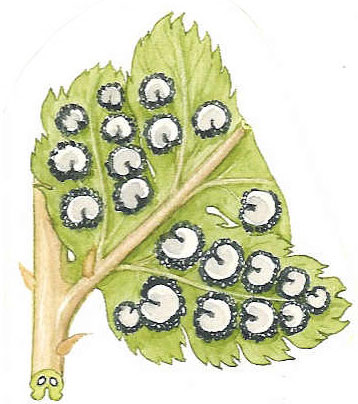|
Hardy Fern Home All Ferns Fern Families ��Aspleniaceae ��Blechnaceae ��Dennstaedtiaceae ��Dryopteridaceae ��Lygodiaceae ��Osmundaceae ��Polypodiaceae ��Pteridaceae ��Thelypteridaceae ��Woodsiaceae Fern Genera ��Adiantum ��Arachniodes ��Aspidotis ��Asplenium ��Astrolepis ��Athyrium ��Blechnum ��Cheilanthes ��Cryptogramma ��Cyrtomium ��Cystopteris ��Dennstaedtia ��Deparia ��Diplazium ��Dryopteris ��Gymnocarpium ��Lygodium ��Matteuccia ��Onoclea ��Oreopteris ��Osmunda ��Pellaea ��Phegopteris ��Pleopeltis ��Polypodium ��Polystichum ��Pteridium ��Pteris ��Pyrrosia ��Thelypteris ��Woodsia ��Woodwardia |
| Dryopteridaceae | ||
|
Absence of needlelike hairs, scaly stem and petiole bases, and nonmarginal sori, exceptions to all; three or more vascular bundles at the base of the stips; FNA discusses with more optimism. Here 4
genera. | ||
| Arachniodes | ||
East Indian holly fern | ||
|
Etymology
From the Greek, arachnion, spider's web + odes, perhaps in allusion to a fancied resemblance of one of the more finely dissected pentagonal species, to a spider's web.
Description
Rhizome: long creeping, tan scales lanceolate.
Frond: evergreen, monomorphic. Stipe: lanceolate scales, vascular bundles: 4 or more in an arc. Blade: 2-pinnate-pinnatifid to 3-pinnate or more, deltate or pentagonal, papery to somewhat leathery, below: hairlike scales. Pinnae: anadromous, proximal pinnae largest, with basal basiscopic pinnule much larger, costae shallowly grooved above, continuous from rachis to costae, segments margins spiny, ultimate segments frequently mucronate, veins free, forked. Sori: round, between midrib and margin, indusium: reniform, attached at a sinus, sporangia: translucent.
Distinctive Characteristics
Arachniodes shares the kidney-shaped indusia and grooves continuous from rachis to costae with Dryopteris (disputed in the Flora of Australia); it differs in an anadromic plan throughout whereas Dryopteris is catadromic above the basal pinna pair, and is said to have creeping rhizomes rather than erect ones, an unconvincing distinction, given a number of species with short-creeping rhizomes in Dryopteris. A mucronate, or bristle-like, terminus at the ends of veins is also present in Arachnoides, a feature shared with many Polystichum.
|
|
|
| Cyrtomium | ||
Asiatic holly fern | ||
|
Etymology
Greek: kyrtoma means arch. The veins rejoin forming an arch.
Description
Rhizome: erect, large tan scales.
Frond: evergreen, monomorphic. Stipe: scaly, vascular bundles: 4 or more, in an arc. Blade: 1-pinnate, oblong-lanceolate; the blade is terminated by a pinna similar to the others, a characteristic called imparipinnate, leathery, filiform scales below, glabrous above. Pinnae: holly-like, distal pinnae only slightly smaller, costae grooves above continuous from rachis to costae, segments crenate to spinulose, veins netted. Sori: round, in 2 or more rows between midrib and margin, indusium: peltate, persistent or not, central, sporangia: brown.
Distinctive Characteristics
shares the peltate indusium with Polystichum as well as, in some cases, an upward ear at the base of the pinnae; differs in a terminal pinna similar to the lateral ones; it shares the grooves continuous from rachis to costae with Dryopteris, and it differs from both in the net veining.
|
|
|
| Dryopteris | ||
Wood fern, buckler fern | ||
|
Etymology
Greek: drys, oak + pteron, a wing, which describes the shape of the pinnae, but the word pteris was used by the ancient Greeks for all ferns.
Description
Rhizome: suberect to erect, nonclathrate scales, no hairs, though occasionally glandular hairs.
Frond: deciduous or evergreen, usually monomorphic. Stipe: grooved, scaly, vascular bundles: 2 primary and 1-5 secondary, all in a c-shaped pattern facing the top of the blade/stipe. Blade: 1-4 pinnate, deltate-ovate to lanceolate, herbaceous to somewhat leathery, linear to ovate scales below, absent above. Pinnae: catadromous to anadromous, costae grooved above, continuous from rachis to costae, segments margins entire, crenate, or serrate, spinulose or not, veins free, forked. Sori: round, in 1 row between midrib and margin, indusium: reniform, at a sinus, sporangia: brownish.
Distinctive Characteristics
Dryopteris is characterized by a kidney-shaped indusium over a round sorus, continuous grooves on the upper side of stipe, rachis, and costa, scaly stipes, lack of hairs, and vascular bundles in a c-shape. There are no simple or pinnatifid Dryopteris, and only one 1-pinnate species, D. sieboldii; otherwise, the range in division is 1-pinnate-pinnatifid to 3-pinnate-pinnatifid. It is similar in many respects to Polystichum, the latter differing in the umbella-shaped indusium and lack of continuity in the grooves between rachis and costa.
|
|
|
| Polystichum | ||
Shield fern | ||
|
Etymology
Polystichum is from the Greek polys, many, + stichos, row. The sori are in many rows.
Description
Rhizome: erect, scales.
Frond: evergreen, monomorphic or weakly dimorphic. Stipe: scaly, vascular bundles: 4 or more, in an arc. Blade: 1-3 pinnate, lanceolate; at emergence the croziers droop backwards, glossy, linear to lanceolate scales below, no hairs. Pinnae: usually an upper side lobe, costae grooved above, grooves discontinuous from rachis to costae, segments spinulose, veins free, forked, anadromic. Sori: round, in 1 (2) rows between midrib and margin, indusium: peltate or rarely absent, central, sporangia: yellow or brownish to black.
Distinctive Characteristics
similar to Dryopteris, but distinguished by the upward ear on the pinnae, commonly spiny margins, the peltate indusia, and discontinuous grooving between rachis and costa. It also has many characteristics in common with Cyrtomium, but the latter has netted veins; here they are always free, perhaps forked.
|
|
|



